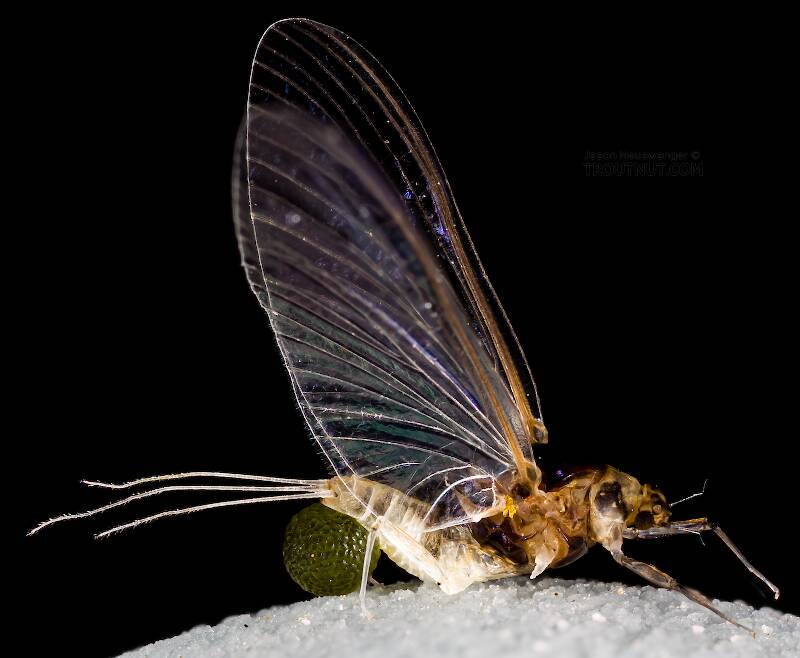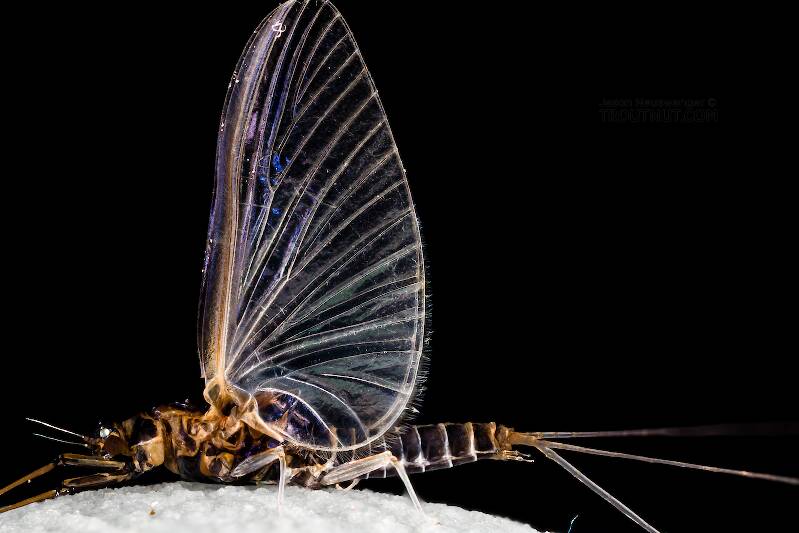
Hex Mayflies
Hexagenia limbata
The famous nocturnal Hex hatch of the Midwest (and a few other lucky locations) stirs to the surface mythically large brown trout that only touch streamers for the rest of the year.
Featured on the forum

This is a striking caddis larva with an interesting color pattern on the head. Here are some characteristics I was able to see under the microscope, but could not easily expose for a picture:
- The prosternal horn is present.
- The mandible is clearly toothed, not formed into a uniform scraper blade.
- The seems to be only 2 major setae on the ventral edge of the hind femur.
- Chloride epithelia seem to be absent from the dorsal side of any abdominal segments.
Based on these characteristics and the ones more easily visible from the pictures, this seems to be Grammotaulius. The key's description of the case is spot-on: "Case cylindrical, made of longitudinally arranged sedge or similar leaves," as is the description of the markings on the head, "Dorsum of head light brownish yellow with numerous discrete, small, dark spots." The spot pattern on the head is a very good match to figure 19.312 of Merritt R.W., Cummins, K.W., and Berg, M.B. (2019). The species ID is based on Grammotaulius betteni being the only species of this genus known in Washington state.
- The prosternal horn is present.
- The mandible is clearly toothed, not formed into a uniform scraper blade.
- The seems to be only 2 major setae on the ventral edge of the hind femur.
- Chloride epithelia seem to be absent from the dorsal side of any abdominal segments.
Based on these characteristics and the ones more easily visible from the pictures, this seems to be Grammotaulius. The key's description of the case is spot-on: "Case cylindrical, made of longitudinally arranged sedge or similar leaves," as is the description of the markings on the head, "Dorsum of head light brownish yellow with numerous discrete, small, dark spots." The spot pattern on the head is a very good match to figure 19.312 of Merritt R.W., Cummins, K.W., and Berg, M.B. (2019). The species ID is based on Grammotaulius betteni being the only species of this genus known in Washington state.

Troutnut is a project started in 2003 by salmonid ecologist Jason "Troutnut" Neuswanger to help anglers and
fly tyers unabashedly embrace the entomological side of the sport. Learn more about Troutnut or
support the project for an enhanced experience here.
This topic is about the Mayfly Genus Tricorythodes
A cult following is something to which few insects can lay claim, but the tiny Tricorythodes mayflies certainly qualify. Their widespread, reliable, heavy hatches draw impressive rises of ultra-selective trout which demand the most of a technical dry-fly angler's skills.It is surprising that such a great hatch took so long to come to the attention of fly fishermen. The Tricos were first introduced to anglers in a 1969 Outdoor Life article by Vincent Marinaro, who misidentified them as Caenis. By the early 1970s the identification had been corrected but Swisher and Richards still wrote in Selective Trout, "Few anglers are familiar with these extremely small but important mayflies." The next wave of publications boosted Tricorythodes to its current fame. I suspect their early dismissal was due in part to tackle limitations; anglers in the 1950s had no means to effectively tie and present size 22-28 flies.
Example specimens
Reify on Jul 8, 2018July 8th, 2018, 3:44 am EDT
What are the differences between Baetis, Caenis and Tricorythodes may flies. I get different answers from different FF buddies.
Thanks in advance
Thanks in advance
Taxon on Jul 8, 2018July 8th, 2018, 8:13 am EDT
Hi Dave-
In their winged lifestages, Baetis mayflies have (2) tails, whereas Caenis and Tricorythodes mayflies have (3) tails.
Caenis and Tricorythodes mayflies, which have only forewings, can be differentiated based on forewing venation, whereas Baetis mayflies generally have greatly reduced hind wings, or for a few species, are completely absent hind wings.
Hope this helps, but if this just leads to more questions, I would be happy to answer them.
In their winged lifestages, Baetis mayflies have (2) tails, whereas Caenis and Tricorythodes mayflies have (3) tails.
Caenis and Tricorythodes mayflies, which have only forewings, can be differentiated based on forewing venation, whereas Baetis mayflies generally have greatly reduced hind wings, or for a few species, are completely absent hind wings.
Hope this helps, but if this just leads to more questions, I would be happy to answer them.
Martinlf on Jul 9, 2018July 9th, 2018, 9:39 am EDT
The Trico hatch for most of here in the East, leads to fishing spinners, which typically fall when the cooler morning air reaches about 70 degrees. This spinnerfall is often an early to late morning event. Those who fish the Trico duns typically fish a female pattern, as the males hatch at night, and the females hatch around sunrise, or earlier, until fall when one may find them coming off mid to late morning in the cooler weather. Spring Baetis, the most fished hatch where I live, typically come off a bit later in the day, between 10 a.m. and 3:00 p.m., though this is not the only time they can hatch. These are duns. I believe both males and females hatch roughly at the same time, unlike Tricos. Fishing the spring Baetis here rarely focuses on spinners, at least in my experience. I don't know much about Caenis.
"He spread them a yard and a half. 'And every one that got away is this big.'"
--Fred Chappell
--Fred Chappell
Quick Reply
Related Discussions
Topic
Replies
Last Reply
1
Jul 22, 2006
by Taxon
by Taxon
3
Oct 30, 2009
by Doublezz105
by Doublezz105






